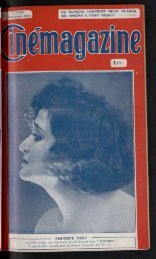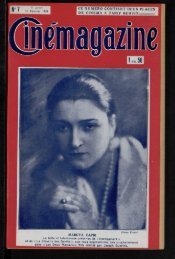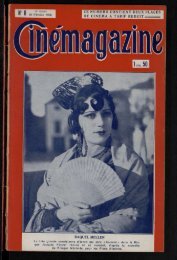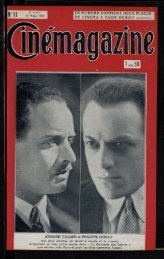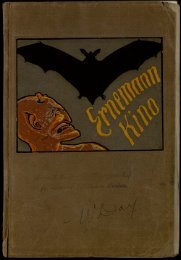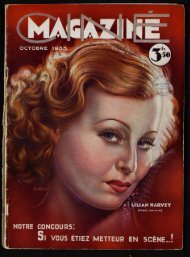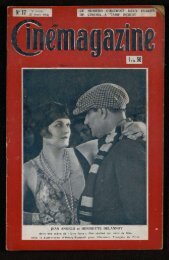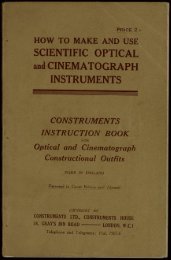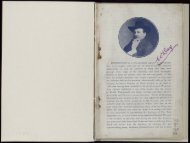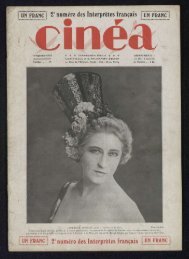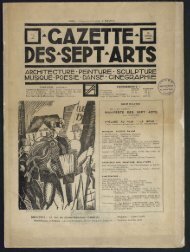Untitled
Untitled
Untitled
Create successful ePaper yourself
Turn your PDF publications into a flip-book with our unique Google optimized e-Paper software.
14 MODERN MAGIC LANTERNS.<br />
In the ordinary form of tray the jet is held by being slid<br />
up or down on the pin of the tray and clamped by means of<br />
the screw, s, Fig. 8. This arrangement, while it allows the<br />
jet to be moved very readily and is simple and reliable, has<br />
the disadvantages that the jet is supported by a point very<br />
much behind its centre of gravity, the pin consequently<br />
tending to lean forward, and that the operator who<br />
manipulates the jet from behind has hold, as it were, of the<br />
short end of a lever, the slightest movement of which displaces<br />
the front of the jet very considerably. The arrangement<br />
also is very easily disturbed by an accidental touch<br />
at the back of the jet ; but, in spite of these drawbacks, this<br />
form of tray is most often met with, and if substantially<br />
made and used with proper care will be found to answer<br />
every purpose. Mr. Andrew Pringle, a recognised authority<br />
on lantern matters, uses in addition an arrangement of a<br />
couple of jaws, which, when the jet has been adjusted in<br />
position, grip it in front, and so help to keep it firm.<br />
All jets are provided with a means of holding the lime for<br />
the flame to play upon, and as the particular part of the<br />
surface soon deteriorates and requires renewal, must have<br />
also an arrangement for bringing a fresh portion of the lime<br />
under the influence of the flame. This in most cases is<br />
effected as shown in Fig. 8, where a vertical spindle, D,<br />
carries a little circular table, E, through the base of which<br />
the spindle projects, the lime being generally a perforated<br />
cylinder in shape, which is slipped over the pin or spindle<br />
and rested on the table. This pin is sometimes made long<br />
enough to carry two limes, one on the top of the other ; this<br />
may be useful for long displays, but we ourselves cannot<br />
recall a time when it would have been a convenience. The<br />
lime pin is connected at its base by means of bevel wheels,<br />
F F, with another spindle, which ends in a milled head, G,<br />
near the taps at the back of the jet ; the pin, however,<br />
while turning with the wheels, is free to move up or down ;<br />
and is indeed compelled to do so when the wheels revolve,<br />
on account of a spiral thread which is cut upon it,<br />
which engages in pins attached to the bracket carrying<br />
the spindle. By this simple contrivance, which is not easily<br />
indicated in the diagram, but which can be comprehended<br />
THE LIMELIGHT. 15<br />
in a moment on looking at a jet, by turning the milled head<br />
G, Fig. 8, the lime pin, and with it the lime, not only revolves,<br />
but at the same time moves up or down, so that a pencil<br />
held upon the side of the lime would describe a spiral line<br />
around it. The handiest form of screw for doing this is one<br />
which raises the lime at least a quarter of an inch for each<br />
complete revolution. A defect some forms of jet possess is<br />
to be found in the fact that the screw is such a fine one that<br />
when the lime has been turned completely round, the jet is<br />
playing upon practically the same place on the lime as<br />
that at which it started.<br />
In some forms of jet, which now have almost gone out of<br />
use, a flat disc of lime was employed instead of a cylinder,<br />
as shown in Fig. 11. In this case the lime simply revolved<br />
Fig. 11. BLOW-THROUGH JET WITH LIME DISC.<br />
upon a central axis, each portion of a revolution sufficing to<br />
bring a fresh part of it before the flame.<br />
The limes for limelight should be turned true, not only as<br />
regards their outer surface, but the hole through the centre<br />
should be central also, since if it is not, the distance between<br />
the jet and the lime will vary as it is turned. As this<br />
distance is an important factor in getting the most light<br />
which a jet is capable of giving, it follows that if one position<br />
of such a lime is correct, on turning it, the distance is altered<br />
and the light diminished In this connection, we may observe<br />
that what are known as "Excelsior "limes are as a rule better<br />
shaped than their rivals, the " Nottingham " limes, although<br />
for the mixed jet the latter are preferable when well formed.<br />
Limes are often spoken of as hard or soft, and these two



